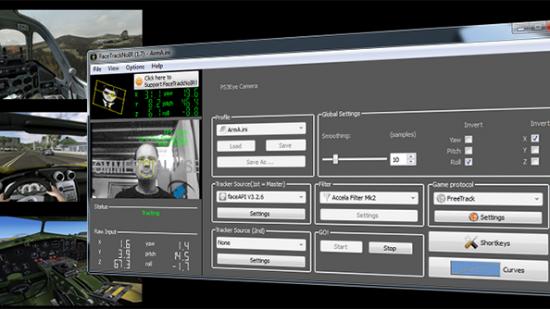We’ve all seen the ways you can fill your limited desk space with all manner of flight yokes, military-style joysticks, rudder pedals, and throttle controls with more buttons than a local haberdashers. However, one of the quirkier ways you can improve your flying experience is to use a motion tracking device that simulates the act of panning your viewpoint simply by turning and twisting your head.
The most well known of these is, of course, TrackIR, a combination monitor-mounted camera and head-mounted sensor (usually necessitating the wearing of a baseball cap – fedora compatible versions are yet to be implemented). The downside is that such tech don’t come cheap – with the latest version costing in the region of $150.
Enter FaceTrackNoIR, an free to download open source project that requires nothing more than your own webcam and a head (preferably your own) to achieve much the same effect as its more expensive ‘professional’ brethren. The project is the brainchild of Netherlands-based Wim Vriend and his team, and with version 1.7 about to go live, we caught up with the motion tracking expert to find out more.
How did the project begin?
I’m a professional software engineer and have worked in Industrial Automation for almost 20 years. In 2004 I fell ill and ultimately ended up ‘disabled’. After that I resumed my job, but only part-time. So I had a lot of time left to devote to my hobby. My friend Ron Hendriks used to game a lot and he discovered that to use headtracking in ArmA you had to either buy an expensive commercial head-tracker or make an IR-headset yourself. He found faceAPI by SeeingMachines on the internet and challenged me to make a free, non-Borg like head-tracker. So we did.
It can’t have been that simple to begin with though. What have been the biggest headaches to date?
There have been some technical challenges, but none of them were really ‘big’. It is a bit of a nuisance that there is no universal protocol to send the data to all games. But that’s also what makes FaceTrackNoIR so popular now: it supports almost all protocols. I think the biggest challenge is communicating with people.
What was the ‘eureka!’ moment for you, the moment when it all clicked?
That was actually quite soon after we began. The first protocol Ron and I implemented was the FreeTrack protocol, which was supported by ArmA. The first time my head was actually moving in-game was a happy moment indeed.
What has been the most satisfying title you’ve managed to get working to date?
Making the 64-bit version of DCS A10C work with it was the most satisfying. The developers of DCS had implemented an interface for alternative head-trackers, but had not released it. So the users that contacted us raised a petition on the internet, which we actively supported. After a week the developers were convinced: they released the interface. After that, it took us only a week to get it all working.
What are your current goals for the program?
We want to provide a platform with challenges, so we can learn a lot of things (outside my normal field of expertise). A project like FaceTrackNoIR involves a lot of work: making, updating and maintaining the software, building and maintaining a website, wiki and forums, etc. Cmmunicating with people (developers and users) literally from all over the world helps with this and is both very educational and fun to do. Also, we basically just want to help people have more fun when gaming.
How much further can you go with the technology? Might we ever go beyond mere face tracking to include Kinect-style tech to track body or arms, for example?
There are still some things that can be improved with the head-tracking. The new version of FaceTrackNoIR is very modular, so new head-trackers, filters and game-protocols can be added easily. One very interesting development we are doing, together with our Dutch friends from vipercore, is the development of an Inertial Head Tracker. All ‘vision-based’ trackers have the disadvantage of requiring good lighting (or no lighting for IR). They also have limited ranges: when moving too much, the tracker will lose track. The Inertial Head Tracker always works.
Will we go beyond mere face-tracking? It is possible to make a body-tracker, using the same technology we are using now. But until now, we don’t see games that support it (not regarding Wii and Kinect-like games, which require specific and expensive hardware). Who knows? As long as pilots and drivers remain seated, there will also be a demand for ‘just’ head-tracking, I guess…
You can grab the latest version of FaceTrackNoIR from the team’s home on Sourceforge where you can also see more videos from happy, head-waggling users.
You’re reading theflight simchannel
at PCGamesN. We combine new, original content with feeds from the best
flight sim websites and reader submissions. For the best, new stuff
about all flight sims, check ourhomepageandfollow ourflight simTwitter accountfor regular updates. Check our retail partner SimStop forFlight Simulator add onsand more.
